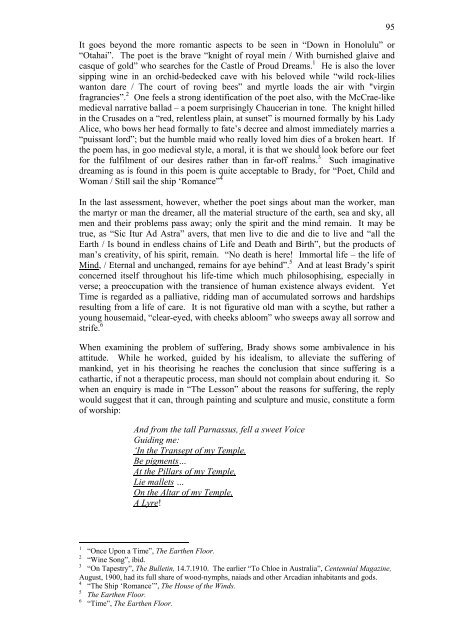A CRITICAL BIOGRAPHY OF EDWIN JAMES BRADY - Mallacoota ...
A CRITICAL BIOGRAPHY OF EDWIN JAMES BRADY - Mallacoota ...
A CRITICAL BIOGRAPHY OF EDWIN JAMES BRADY - Mallacoota ...
Create successful ePaper yourself
Turn your PDF publications into a flip-book with our unique Google optimized e-Paper software.
It goes beyond the more romantic aspects to be seen in “Down in Honolulu” or<br />
“Otahai”. The poet is the brave “knight of royal mein / With burnished glaive and<br />
casque of gold” who searches for the Castle of Proud Dreams. 1 He is also the lover<br />
sipping wine in an orchid-bedecked cave with his beloved while “wild rock-lilies<br />
wanton dare / The court of roving bees” and myrtle loads the air with "virgin<br />
fragrancies”. 2 One feels a strong identification of the poet also, with the McCrae-like<br />
medieval narrative ballad – a poem surprisingly Chaucerian in tone. The knight hilled<br />
in the Crusades on a “red, relentless plain, at sunset” is mourned formally by his Lady<br />
Alice, who bows her head formally to fate’s decree and almost immediately marries a<br />
“puissant lord”; but the humble maid who really loved him dies of a broken heart. If<br />
the poem has, in goo medieval style, a moral, it is that we should look before our feet<br />
for the fulfilment of our desires rather than in far-off realms. 3 Such imaginative<br />
dreaming as is found in this poem is quite acceptable to Brady, for “Poet, Child and<br />
Woman / Still sail the ship ‘Romance” 4<br />
In the last assessment, however, whether the poet sings about man the worker, man<br />
the martyr or man the dreamer, all the material structure of the earth, sea and sky, all<br />
men and their problems pass away; only the spirit and the mind remain. It may be<br />
true, as “Sic Itur Ad Astra” avers, that men live to die and die to live and “all the<br />
Earth / Is bound in endless chains of Life and Death and Birth”, but the products of<br />
man’s creativity, of his spirit, remain. “No death is here! Immortal life – the life of<br />
Mind, / Eternal and unchanged, remains for aye behind”. 5 And at least Brady’s spirit<br />
concerned itself throughout his life-time which much philosophising, especially in<br />
verse; a preoccupation with the transience of human existence always evident. Yet<br />
Time is regarded as a palliative, ridding man of accumulated sorrows and hardships<br />
resulting from a life of care. It is not figurative old man with a scythe, but rather a<br />
young housemaid, “clear-eyed, with cheeks abloom” who sweeps away all sorrow and<br />
strife. 6<br />
When examining the problem of suffering, Brady shows some ambivalence in his<br />
attitude. While he worked, guided by his idealism, to alleviate the suffering of<br />
mankind, yet in his theorising he reaches the conclusion that since suffering is a<br />
cathartic, if not a therapeutic process, man should not complain about enduring it. So<br />
when an enquiry is made in “The Lesson” about the reasons for suffering, the reply<br />
would suggest that it can, through painting and sculpture and music, constitute a form<br />
of worship:<br />
And from the tall Parnassus, fell a sweet Voice<br />
Guiding me:<br />
‘In the Transept of my Temple.<br />
Be pigments…<br />
At the Pillars of my Temple,<br />
Lie mallets …<br />
On the Altar of my Temple,<br />
A Lyre!<br />
1 “Once Upon a Time”, The Earthen Floor.<br />
2 “Wine Song”, ibid.<br />
3 “On Tapestry”, The Bulletin, 14.7.1910. The earlier “To Chloe in Australia”, Centennial Magazine,<br />
August, 1900, had its full share of wood-nymphs, naiads and other Arcadian inhabitants and gods.<br />
4 “The Ship ‘Romance’”, The House of the Winds.<br />
5 The Earthen Floor.<br />
6 “Time”, The Earthen Floor.<br />
95


